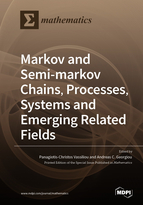Markov and Semi-markov Chains, Processes, Systems and Emerging Related Fields
A special issue of Mathematics (ISSN 2227-7390). This special issue belongs to the section "Probability and Statistics".
Deadline for manuscript submissions: closed (30 June 2021) | Viewed by 31636
Special Issue Editors
Interests: probability; stochastic processes; stochastic modeling; applied probability; financial mathematics; stochastic analysis; mathematical finance; Markov chains; Markov processes; option pricing
Special Issues, Collections and Topics in MDPI journals
Interests: Markovian processes; stochastic modeling; manpower planning; multiple objective optimization; simulation; performance evaluation; business analytics
Special Issues, Collections and Topics in MDPI journals
Special Issue Information
Dear Colleagues,
Modern Probability has a face with two different sides. One side is the closest possible to being a branch of pure mathematics, derived from certain axioms in classical areas of algebra. On the other side, however, probability is an applied mathematics discipline, most commonly known as applied probability, although the usual distinction between pure and applied mathematics is, in our opinion, merely artificial. This side, without being less demanding mathematically or stochastically, produces valuable models for studying everyday phenomena in the real world. Stochastic processes are by now well established as an extension of probability theory. In the area of stochastic processes, Markov and semi-Markov processes play a vital role as an independent area of study, generating important and novel applications and new mathematical results. Additionally, they play a vital part in emerging new areas of research by blending with dynamic developing areas of statistical research and large-scale data manipulation.
We invite our colleagues to submit papers to areas related to the following keywords and also in any closed linked field of study not mentioned specifically here.
Prof. Dr. Andreas C. Georgiou
Prof. Dr. Panagiotis-Christos Vassiliou
Guest Editors
Manuscript Submission Information
Manuscripts should be submitted online at www.mdpi.com by registering and logging in to this website. Once you are registered, click here to go to the submission form. Manuscripts can be submitted until the deadline. All submissions that pass pre-check are peer-reviewed. Accepted papers will be published continuously in the journal (as soon as accepted) and will be listed together on the special issue website. Research articles, review articles as well as short communications are invited. For planned papers, a title and short abstract (about 100 words) can be sent to the Editorial Office for announcement on this website.
Submitted manuscripts should not have been published previously, nor be under consideration for publication elsewhere (except conference proceedings papers). All manuscripts are thoroughly refereed through a single-blind peer-review process. A guide for authors and other relevant information for submission of manuscripts is available on the Instructions for Authors page. Mathematics is an international peer-reviewed open access semimonthly journal published by MDPI.
Please visit the Instructions for Authors page before submitting a manuscript. The Article Processing Charge (APC) for publication in this open access journal is 2600 CHF (Swiss Francs). Submitted papers should be well formatted and use good English. Authors may use MDPI's English editing service prior to publication or during author revisions.
Keywords
- Markov chains and Markov processes
- semi-Markov chains and processes
- Markov renewal processes
- matrix analysis in stochastic processes and applications
- nonhomogeneous Markov and semi-Markov systems
- discrete and continuous time Markov chains
- stochastic analysis for finance
- stochastic processes in social sciences
- Martingales and related fields
- first step analysis and random walks
- stochastic stability and asymptotic analysis
- perturbation and sensitivity analysis in Markov processes
- queuing networks and Markov chains
- Markovian modeling and applications in biology, epidemiology and healthcare
- inference in Markov, semi-Markov and diffusion processes
- Markov reward models
- reversible Markov chains
- Monte Carlo methods and simulation-related fields
- Markov chains and computer science
- optimization techniques and efficiency evaluation
- hidden Markov chains and applications
- modeling and applications in classification and machine learning







